News in Brief
Study Aims to Protect Elk on Roadways with Collar-Activated Signs
A study underway will help determine whether electronic detection of elk along North Coast highways will help protect elk, as well as human drivers.
Micaela Szykman Gunther, Wildlife Professor, and undergraduate and graduate students are focused on a particular stretch of highway near Stone Lagoon, about 30 miles north of Arcata, that the California Department of Fish and Wildlife has designated as an area of concern for traffic collisions with wildlife. They are researching if warning signs installed along highways that signal to drivers when collared elk are on or close to the roadway will slow down drivers and reduce collisions.
Gunther has spent seven years monitoring elk along the North Coast, collaborating with biologists at the California Department of Fish and Wildlife to track their movements and other behaviors to better understand and conserve the species.
Preliminary data collection for this study includes analyzing data on elk movements and road crossings to inform the Electronic Detection System, which will run on software designed by the technology company Lotek. With assistance from Caltrans, Gunther hopes to have the physical system in place by next year.
Highways fragment elk and other wildlife habitats, serving as impediments to daily and seasonal movements. Crossing highways to access available habitat increases the chances of wildlife-vehicle collisions that affect both human and wildlife safety, as well as damage property. Implementing an Electronic Detection System that alerts drivers to a hazard (i.e., a large elk) on the roadway can mitigate damage and loss.
While the elk have collars to track them, the study also focuses on the behavior of another species: humans. Researchers will be developing signage that stands out from static wildlife crossing signs, and that will be triggered to flash lights when collared elk approach the roadway, similar to pedestrian crossing signage that has been adopted across California in the last decade.
Gunther and students are observing how motorists respond to the signage to understand if they reduce their speed and, as a result, the number of wildlife-vehicle collisions and other incidents along the highway.
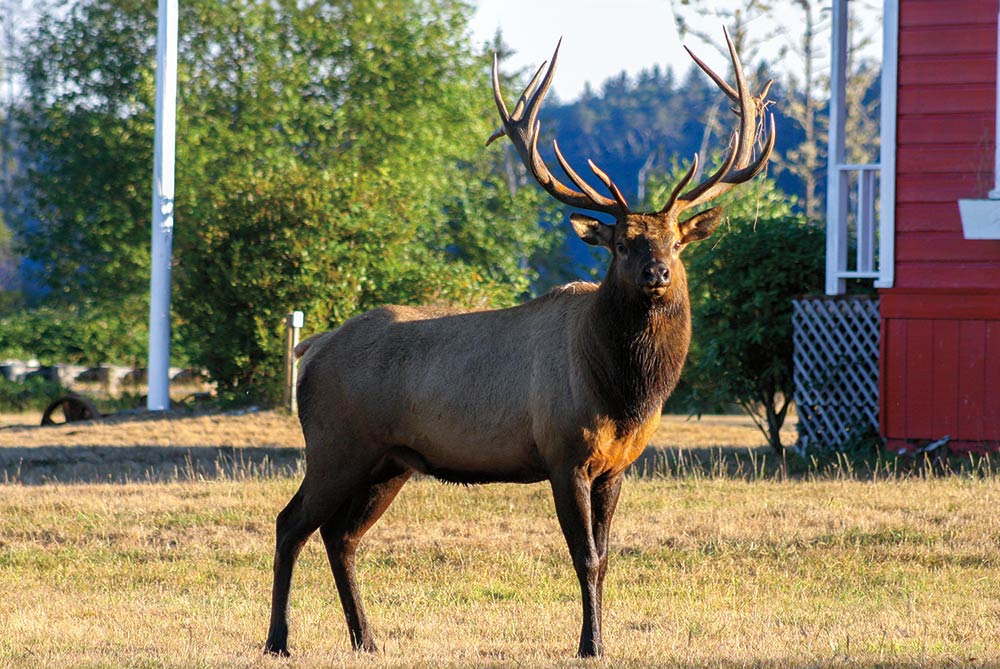
Roadways with collar-activated signs will help protect elk and people driving along a stretch of Highway 101 near Stone Lagoon.
Promotorx Transformative Educator Program Empowers Future Educators and Local Youth
THE NATION’S CLASSROOMS ARE BECOMING MORE DIVERSE, underscoring the need for a teaching force and curricula that reflect this diversity.
For this reason, Education Professor Marisol Ruiz created the Promotorx Transformative Educator Program. Program fellows learn to create sustainable curricula and literacy workshops driven by the needs of the youth they work with. It is funded by the U.S. Department of Education’s Developing Hispanic-Serving Institutions grant.
The program has taught Education graduate student and fellow Gina Cerda Salvarrey sustainable pedagogies that she can put into practice.
“It’s very motivating professionally because the students allow me to learn from them and about the needs they have as non-dominant students,” Cerda Salvarrey adds. “But what is most impactful for me is when students comment that this is the first time a class has given them a space where they can express themselves and show their abilities without fear.”
The program also gives its fellows resources they need for success. For example, fellows fulfill service hours needed to apply for credential programs and prepare for the CSET and CBEST exams. They also learn about policy, decolonizing pedagogy, and how to approach issues such as harassment.
“It's important for people who want to be teachers to understand the dynamics of learning,” Ruiz says. “It's not just teaching and learning—there's so much happening in schools." For Cerda Salvarrey, “it has been a niche where we can explore ideas and reimagine the educational world we want to be a part of.”
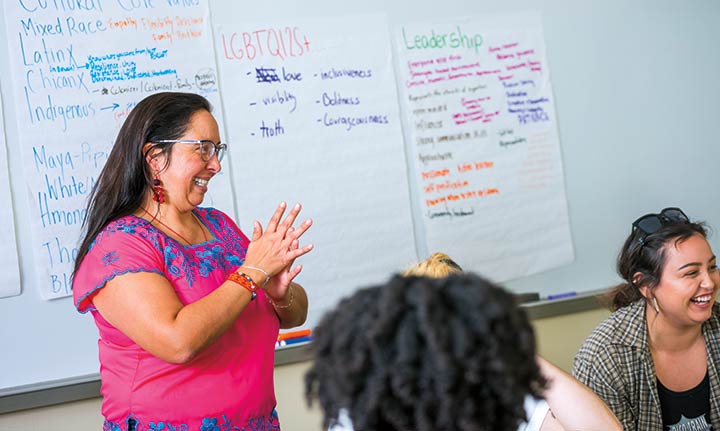
Education Professor Marisol Ruiz created the program to help teach future educators how to incorporate student experiences and counter-narratives into curriculum.
Navigating AI
DUE TO ITS RAPID EVOLUTION, artificial intelligence is a popular topic among academics. It has transformed into a tool capable of answering complicated questions and even writing entire papers within minutes.
“Two years ago, AI tools were simpler, but now companies like ChatGPT and many others are evolving AI at a pace that academia was unprepared for. As educators, we should seriously consider its implications for teaching and learning and find mindful ways to incorporate it into the classroom to improve learning outcomes where relevant,” says Enoch Hale, director of Cal Poly Humboldt’s Center for Teaching & Learning.
The Center is helping faculty navigate the new academic world overwhelmed by AI with caution and intention.
While some believe AI could negatively affect students' critical thinking skills, others—like Political Science Professor Noah Zerbe—believe it is another tool students can use in their coursework.
Zerbe teaches his students how to use it for their assignments. One of his assignments asks students to use ChatGPT to provide feedback on their papers, like outlining missing concepts.
“Teaching students how to use AI effectively is important. It’s useful for clarifying concepts, brainstorming, and editing writing. Through my assignments and courses, I guide students through effectively using AI and emphasize the importance of fact-checking and not blindly relying on AI-generated content,” Zerbe says.
Zerbe also requires students to explain how they use AI software and analyze its results.
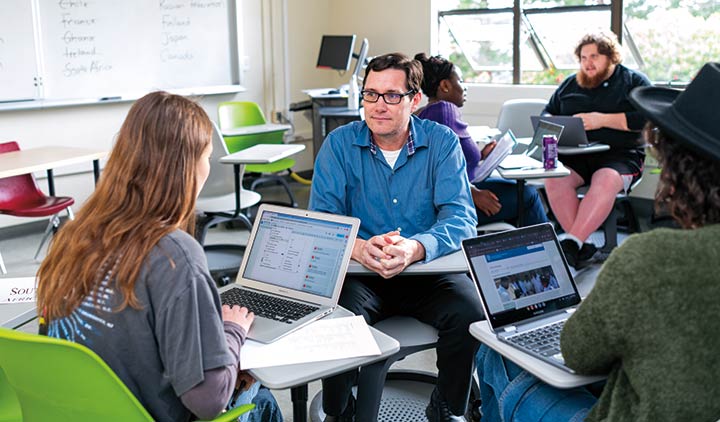
Political Science Professor Noah Zerbe teaches his students how to use AI for assignments.
“We're teaching our students to be critical thinkers. Therefore, engaging critically with AI is just as important as engaging critically with any other source,” Zerbe says.
He believes future employers will expect graduates to know how to use AI effectively in the way an engineer would know how to use a calculator.
“It's certainly not going away. I think that trying to ignore it or pretend like it doesn't exist, or not thinking about how to integrate it into teaching, is problematic. That's why I've been embracing it. I think it’s the future,” Zerbe says.
Students Shine at Model UN Conference in New York City
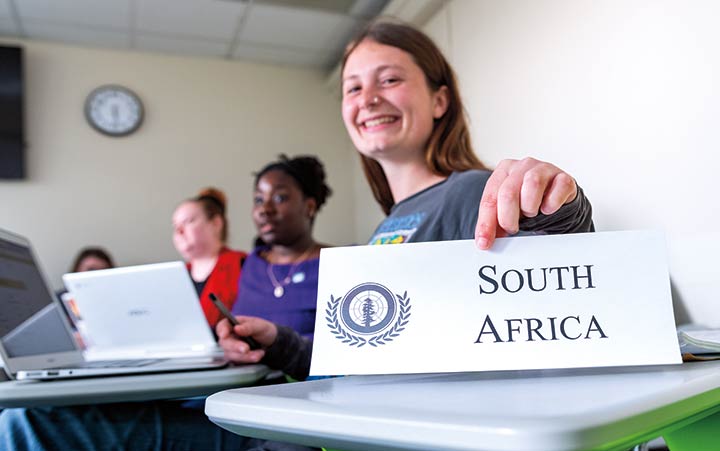
Cal Poly Humboldt's Model UN students spend the year learning debate rules, studying negotiation and consensus building, and researching their assigned countries before a competition.
OVER THE LAST YEAR, several dozen students spent months analyzing the complex challenges facing Algeria, Ethiopia, Malta, and Guinea-Bissau, preparing how best to represent their assigned countries.
Their hard work culminated in March, when the team won an Outstanding Delegation Award, placing it in the top 20% of teams at the Model United Nations Conference in New York. It was the highest ranking a team from Humboldt has ever achieved.
ModelUN is a worldwide organization that sees students roleplay as delegates for nations, research and propose policy, debate, give speeches, and negotiate with each other—as the real UN does. These experiences build a variety of skills that are applicable in a wide array of fields.
Each year Political Science Professor Noah Zerbe teaches a course that prepares students to compete in two competitions: a smaller, regional conference in San Francisco and the national conference in New York City. The San Francisco conference acts as an introduction to competition for most students, and those with more experience attend the New York conference.
The New York conference sees more than 5,000 students from around the world competing at a high level. Many of them get years of training, and get support from the diplomatic structures of their home governments.
Humboldt makes its name with a scrappier approach. Students spend the year learning the rules of Model UN debate, studying negotiation and consensus building, and researching the countries they’ve been assigned to represent. They research policies and develop resolutions and position papers based on committees that reflect their skills and interests.
The skills that Model UN develops—team building, negotiation, and public speaking—have to be applied.
“That sense of self-confidence is not something you can teach,” Zerbe says. “They have to experience it. And it's even more transformative for the students who feel unprepared.”
College Corps Humboldt Prepares Students for Leadership Development
ONE HUNDRED AND TWENTY FULL-TIME STUDENTS from Cal Poly Humboldt and College of the Redwoods are pledging to help 25 local nonprofits as part of the statewide Calfornians ForAll College Corps program.
Through service activities and leadership development, College Corps seeks to foster a new generation of civic-minded leaders who can help bridge divides, solve problems, and address pressing social issues to build stronger and more equitable communities across California. In addition, the program provides financial support to low- and middle-income students, helping to reduce their debt burden and making it easier for them to graduate confidently and without debt.
“This program helps students to pay for college. But it doesn't only do that. College Corps allows students to practice service leadership in our local community and support and uplift local nonprofits. It's a win-win-win: good for the students, the campus, and the community,” says Sara Hart, College Corps principal investigator and Religious Studies Professor.
In January 2022, the state awarded Cal Poly Humboldt $3.3 million to support approximately 100 students yearly for their community projects and community partners that host students through the 2025-2026 academic year. Since the announcement, Humboldt partnered with Founders Mark, an organization that provides career training for young adults, to develop a custom curriculum in service leadership for College Corps fellows. As part of their curriculum, the fellows collaborate with their local nonprofit community partners to identify a challenge faced by those community partners and to develop potential solutions as their final project.
This spring, College Corps Fellows pitched their proposed solutions to a panel of national nonprofit leaders in a Shark Tank-style event. The fellows spent the remainder of the academic year activating their ideas and solving the immediate problems that their community partners identified.
In addition to working with their community partners, College Corps fellows will partner with the University’s three colleges to offer service-oriented programs. The College of Arts, Humanities & Social Sciences held an Art in Service series.
“Our goal with these projects is largely on-campus outreach. College Corps is a new program. Partnering with the colleges on projects involving faculty and students— including College Corps fellows—is a way for us to get the word out about the program,” Hart says.
New Vessel to Support Research
To reveal the mysteries of our ocean, Cal Poly Humboldt is looking toward the future with a new oceanographic research vessel.
The 78-foot-by28-foot custom-built aluminum catamaran powered by twin 1,100-horsepower Tier 4 engines will travel at speeds up to 24 knots. The vessel—expected to be operational in early 2025—will carry up to 40 students, faculty, and crew on day trips and accommodate up to 14 people on multi-day research voyages. The vessel will have a variety of hydraulic deck machinery for handling up to 5,000 pounds of oceanographic equipment and instrumentation.
The deck will also accommodate divers entering the water from two dive platforms off the stern. The vessel’s laboratory and pilot house will carry a diverse array of state-of-the-art navigation and oceanographic electronics to measure physical and biological features of the ocean bottom and water column.
The legacy of fostering undergraduate and graduate academic experiences while promoting marine research spans decades with programs and facilities that include the R.V. Coral Sea.
Since then, thousands of students have learned first-hand everything from gathering and analyzing water and sediment samples to collecting fish from the deep ocean.
Though well-maintained, the Coral Sea turns 50 this year, far exceeding the average 30-year lifespan of a research vessel. In addition, the state passed new emission standards effective in 2026 for vessels in the Coral Sea’s class, and replacing the ship’s five diesel engines to meet the new standards would cost up to $2 million.
The new $7.9 million new research vessel is made possible by the state’s historic investment in Humboldt’s expansion as a polytechnic university.
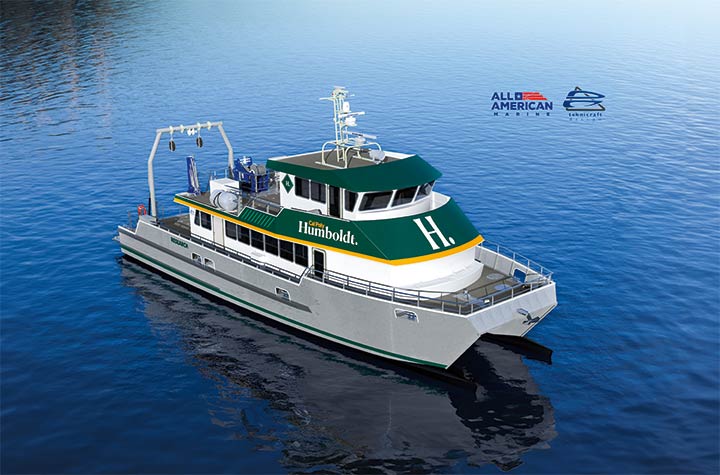
Transformative Energy Solution for Rural Northern California Tribes
The Tribal Energy Resilience and Sovereignty Project (TERAS) aims to empower four Tribes in Northern California to convert one of the state's least reliable electrical circuits into a highly resilient renewable energy system.
The project is supported by $88 million in funding from the Department of Energy's Grid Resilience and Innovative Partnerships (GRIP) program. It is expected to advance Tribal energy sovereignty, climate resilience, jobs equity, and clean energy innovation.
The "Hoopa 1101" distribution circuit, which spans 142 miles, provides electricity to three Tribes in eastern Humboldt County – the Hoopa, Yurok, and Karuk Tribes. These Tribes frequently experience long power outages. To address this issue, they are collaborating with the Blue Lake Rancheria Tribe, the Redwood Coast Energy Authority (RCEA), Pacific Gas & Electric (PG&E), and Cal Poly Humboldt’s Schatz Energy Research Center to develop nested microgrid solutions.
The project will include the deployment of three nested microgrids for the Hoopa, Yurok, and Karuk Tribes. These microgrids will be capable of powering a portion of PG&E's electrical circuit during local outages and will be able to function jointly or independently as necessary.
The Blue Lake Rancheria (BLR) is also expanding its own campus energy system into four nested, behind-the-meter microgrids to support the project. This expansion will provide a demonstration site for the control system that will subsequently be deployed along the Hoopa 1101.
The technical development for TERAS is being led by the Schatz Center, which has previously worked on innovative renewable energy projects in California. The Tribal partnership involved in the project sees this initiative as a crucial step towards energy sovereignty and resilience. The project is also seen as a model for rural communities and is focused on intertribal collaboration.
Walker’s courses were famous for their detail and rigor. He insisted on showing students living samples and driving 250 miles to the Bay Area to acquire ginkgo trees for class the next day. His teaching collection of ferns and conifers lives on in the greenhouse.
Reasons to Cheer: New Sports Channel Lumberjack Spirit
NEW COLLEGIATE SPORTS are expanding opportunities for student-athletes and Lumberjacks fans as the University continues to grow. With the planned addition of Wrestling in the 2024-25 year, Cal Poly Humboldt Athletics will have a slate of 14 sports teams that compete at the Division II level.
Humboldt will become only the second NCAA Division II men's wrestling program, along with San Francisco State University, in the 23-campus California State University system. Lennie Zalesky was hired as the head coach in March and has since been building a roster for the resurging program.
The Lumberjacks have a rich, storied history of wrestling. The program launched in 1952 and flourished under the legendary late coach Frank Cheek, the all-time winningest coach in Humboldt history. Due to budget considerations and the withdrawal of several conference members from the sport, Humboldt dropped intercollegiate wrestling.
Virgil Moorehead (‘83, Education), Craig Vejvoda (‘80, Business Administration), and Dan Phillips (‘91, Business and Computer Information Systems), who were members of the Humboldt wrestling community, have each committed a gift of $50,000 to help build upon Cal Poly Humboldt's wrestling legacy.
The project will include the deployment of three nested microgrids for the Hoopa, Yurok, and Karuk Tribes. These microgrids will be capable of powering a portion of PG&E's electrical circuit during local outages and will be able to function jointly or independently as necessary.
Cal Poly Humboldt and College of the Redwoods are set to launch a new men's and women's rodeo program in 2024. This innovative collaboration will provide students with exceptional opportunities to engage in rodeo activities while pursuing their degrees at both institutions.
Men's and Women's Indoor Track & Field recently completed its first season. The teams are composed of existing members of the Outdoor Track & Field team. The inclusion of Indoor Track & Field allows athletes to dedicate more time during the fall and winter to refine their skills and participate in competitive races that surpass the benefits of regular practice sessions in the winter months.
And in 2022, Humboldt became the 42nd program to offer women's triathlon at the collegiate level. In October 2023, the team finished fourth among Division II opponents and 12th out of 16 teams at the West Regional Championship.
First New Academic Building of the Polytech Era
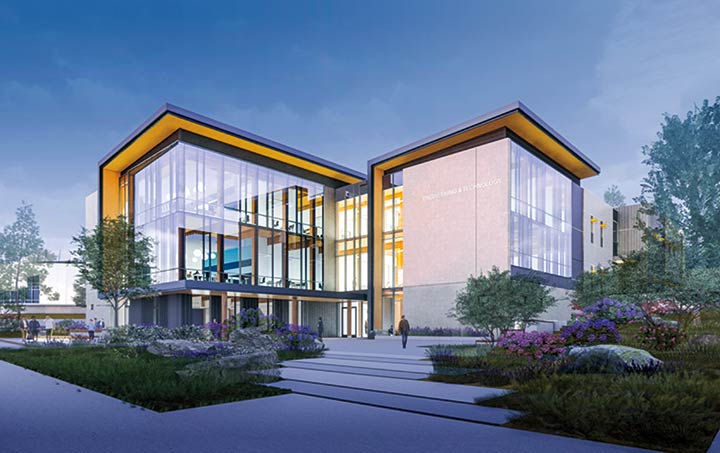
Ushering in a new era for Northern California’s first polytechnic university, construction is about to begin on Cal Poly Humboldt’s Engineering & Technology Building. The flagship building of the polytechnic transformation will be Humboldt's first major academic infrastructure project since 2008 and will emphasize student-centered learning and sustainable design.
The $100 million project was made possible with one-time funding from the historic $458 million investment in the University’s polytechnic effort approved by Governor Gavin Newsom and the State Legislature in 2021.
The 74,000 square-foot, three-story structure designed by AC Martin will be located at the northeast corner of B and 17th streets, the current site of the Campus Events Field. Swinerton began construction in May 2024, with opening planned for Spring 2026.
The building will provide much-needed lab and research spaces, faculty offices, and student support spaces that promote collaboration and hands-on learning. It will house the School of Engineering and its five high-demand bachelor’s and master’s programs: Energy Systems Engineering, Engineering & Community Practice, Environmental Resources Engineering, Environmental Systems, and Mechanical Engineering. It will also accommodate the Computer Science and Software Engineering degree programs.
The state-of-the-art facility will highlight the University’s long-standing commitment to sustainable practices. Rather than being made of steel, the beams are mass timber sourced from the Pacific Northwest. This will be the University's first mass timber building. Proposed sustainability features include high-efficiency irrigation, water-efficient plumbing, and energy-efficient and Cal Green-compliant lighting and appliances. Its rooftop will have solar panels consistent with CSU Sustainability Policy and will be integrated into the future campus microgrid system.
The interior spaces reflect Cal Poly Humboldt’s vision as a polytechnic for the 21st century: a university where STEM and the liberal arts programs intersect and are grounded in practical experience for students. Designed to foster interaction across disciplines, most of the building's classrooms and labs will be used for everything from classes to meetings. An interdisciplinary makerspace will feature wood and metal shops, project storage, and fabrication spaces.